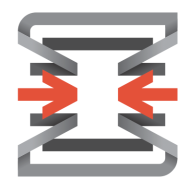


OPNsense and Check Point Quantum Force (NGFW) are leading contenders in the firewall industry. Check Point Quantum Force seems to have an edge over OPNsense due to its advanced threat prevention and integration capabilities, though this comes at a higher price point.
Features: OPNsense is renowned for its flexibility, user-friendliness, and extensive reporting tools, making it a preferred choice for small businesses. Its open-source nature ensures it is both customizable and cost-effective. Check Point Quantum Force excels in advanced threat prevention, centralized management, and integration with other systems. Its management console offers detailed reporting, enhancing its functionality for comprehensive security needs.
Room for Improvement: OPNsense could improve in areas such as virtual server integration, high-traffic performance, and VPN stability. Advanced threat intelligence tools are also needed. Check Point Quantum Force is noted for its complexity and steep learning curve, with users finding the interface and configurations cumbersome. Enhancing support services and integrating better with other vendors could benefit the product.
Ease of Deployment and Customer Service: OPNsense is favored for its ease of deployment, allowing straightforward setup managed independently by users. Community support is ample through resources and forums. Check Point Quantum Force, while robust, is more complex to deploy and demands substantial technical support, increasing deployment costs and time, which can be a challenge for smaller firms.
Pricing and ROI: OPNsense offers an open-source solution with free licensing, making it highly cost-effective for small businesses. The absence of recurring fees contributes to an attractive ROI. Check Point Quantum Force's advanced features justify its higher pricing, though this may deter small businesses. Its competitive pricing is favorable with negotiation, making it valuable for organizations that can manage the investment.
Clients are now comfortable and not wasting productive hours on IT support.
The automation part is giving us a cost benefit and speed; we can react faster.
It's a very useful tool to mitigate and protect your enterprise.
This is a time-saving measure because we don't need to deploy a cluster or a firewall each time; we just create a virtual system on the management server using the same appliance.
Incident response time has reduced significantly, and downtime due to network issues has been minimized, leading to an improved return on investment.
The fact that we've not had any breach toward the data center side is plenty enough.
The network attacks reduced by approximately 60% after using that, even without customizing the custom configuration yet.
For a very little investment, I was able to increase the security of my network.
They offer very accurate solutions.
The quick resolution of issues with Fortinet FortiGate is due to the support of the company and the fact that the equipment is easy to work with.
I would rate the technical support for Fortinet FortiGate a ten out of ten.
The support team we engaged was knowledgeable and well-versed with the application.
We have escalated issues to Check Point technical support multiple times and have received timely and very good responses.
Even challenging issues like those with VPNs have been resolved efficiently with their help.
Compared to some open-source projects with weak support, OPNsense stands out for having both a strong community and commercial backing options.
I mainly rely on community support since the solution is open source.
If you say you do not have one, it is finished. This is where the monopoly starts.
They scale up really well from smaller models like the FortiGate 40 and 50 to bigger sites with the FortiGate 100 for more throughput - up to enterprise datacenters.
The variation comes in terms of the interfaces and throughputs, but from a security perspective, you get the same benefit, irrespective of whether you have an entry-level unit or an enterprise.
We determine sizing based on multiple factors: number of users, available links, traffic types, server count, services in use, and whether services will be published.
If specified correctly, even the smaller boxes offer high session and bandwidth rates, making the solution highly scalable, even up to telco-level requirements.
It is easy to scale up by adding capacity through clustering or upgrading the license, and it effectively handles spikes in remote user connections or increased east-west traffic without noticeable bottlenecks.
Scalability must be carefully planned for, considering future growth and user base increases.
Aside from these aspects, it demonstrated good scalability.
It supports routing, VPN setups, and traffic monitoring with additional packages like Snort and Suricata.
OPNsense is an extremely scalable solution.
We're experiencing 99.999% availability consistently.
I would rate the stability of Fortinet FortiGate a ten out of ten.
Currently, we are experiencing a general outage of one of the main internet service providers of the Dominican Republic, and we have not been impacted in our operations because with SD-WAN, we have another internet service provider and we are working with the second WAN connection without any disruption.
While the solution is generally stable, there are complications, such as requiring SmartConsole for deployment and upgrades, which can be time-consuming.
I have worked with Check Point products for 15 years and haven't found any stability or performance issues.
The use of Check Point firewalls has helped improve our security posture without any downtime.
For home and small network use, OPNsense is also reliable, providing enterprise-grade security at no cost.
OPNsense is the same, but it does have a way of installing the Realtek drivers, which gives you a lot more stability overall on the system.
The only challenge faced was its inadequacy to manage large voice traffic effectively, even with dedicated hardware.
Investing in a solution that can accommodate such growth would be more cost-effective than repeatedly purchasing new hardware.
While Fortinet claims to offer a comprehensive network solution, it falls short in addressing computer application issues, particularly server security.
When considering Sophos XG, which we also use, the logging and reporting functionality is notably more efficient.
Other products, like FortiGate, are perceived as more intuitive because they are easier to configure from the start.
More granularity and control for threat prevention, especially on the OT side, would be beneficial.
It would be beneficial for Check Point NGFW to integrate more advanced AI and machine learning algorithms for better threat detection and response.
For high availability, it's crucial to have a method in place where a designated component oversees the entire process.
Improved guidance on package usage and integration beyond relying on external tutorials or community support would be beneficial.
I would like the APIs to be more mature and more developed and have more options to automate threat hunting.
Last year, I renewed the support for three years, which can sometimes be expensive but depends on the security benefits and how it helps us.
It offers cost savings as it is generally cheaper than the competition.
It is about 20% cheaper.
In comparison to Fortinet and other products, the pricing may be considered high.
Compared to other solutions, the pricing of Check Point NGFW is high.
The perception is that Check Point NGFW is expensive, especially when all software modules are included.
It is a free solution, and when you compare it to alternatives like FortiGate, which is quite powerful but also costly, the value becomes evident.
I would rate the pricing a nine out of ten, especially considering the availability of a free community edition.
It is free.
In terms of security, we have not experienced any security flaws or loopholes, and it has proven to be quite stable.
FortiGate has helped reduce the risk of cyberattacks that might disrupt our client's production.
These features help reduce our downtime, manage the ISPs, and deploy SLAs for all the website traffic.
The firewall's default behavior of blocking all traffic, including a cleanup rule that blocks everything from external to internal sources, is highly valuable for protecting our network.
The most valuable features in my experience include perimeter firewalling, cloud and mobile security, application control, URL filtering, DLP, threat prevention, intrusion protection, and safeguarding against malware, botnets, and zero-day attacks.
Since implementing it, we have noticed a lot less getting through that maybe other antivirus within firewalls had failed to catch.
The most valuable features include the basic firewall functionality and the GeoIP location services.
I can have a Wi-Fi VLAN and feel secure that the server network or the VM network that I have on a different VLAN are isolated, and they cannot talk to one another, which adds a great level of security.
It offers enterprise-grade features such as intrusion detection and prevention system, VPN support, traffic shaping, and web filtering, all without license cost.
| Product | Market Share (%) |
|---|---|
| Fortinet FortiGate | 20.4% |
| OPNsense | 11.0% |
| Check Point Quantum Force (NGFW) | 2.8% |
| Other | 65.80000000000001% |



| Company Size | Count |
|---|---|
| Small Business | 350 |
| Midsize Enterprise | 129 |
| Large Enterprise | 187 |
| Company Size | Count |
|---|---|
| Small Business | 132 |
| Midsize Enterprise | 98 |
| Large Enterprise | 195 |
| Company Size | Count |
|---|---|
| Small Business | 30 |
| Midsize Enterprise | 5 |
| Large Enterprise | 8 |
Fortinet FortiGate excels in providing integrated VPN, firewalling, and Unified Threat Management (UTM) with centralized management and high availability. It supports remote access and comprehensive threat protection, making it a preferred choice for securing networks.
Fortinet FortiGate offers a robust security platform with features such as strong intrusion prevention, application control, and web filtering. Its integration with Active Directory and SD-WAN functionality provides scalable solutions for large networks. Users appreciate its ease of use through centralized management interfaces, ensuring robust security with flexible configurations. However, FortiGate could enhance its graphical interface and technical support responsiveness, address firmware bugs and costly licensing, improve logging, integrate better with third-party tools, and strengthen scalability and memory for log storage. Complexity in configuration and the need for intuitive features are noted challenges, and there's a demand for advanced security, zero-trust capabilities, and AI integration.
What are the key features of Fortinet FortiGate?Fortinet FortiGate is widely implemented across industries like education, finance, and government. Companies use it for firewall protection, VPN, and SD-WAN capabilities, ensuring secure perimeter and data center security. It facilitates remote access management and traffic routing optimization, offering reliable security and connectivity solutions.
Check Point Quantum Force NGFW provides centralized management with scalable security for network perimeters. As a reliable firewall, it ensures advanced threat prevention and offers seamless integration, making it suitable for various network environments.
Offering comprehensive security, Check Point Quantum Force NGFW helps control ingress and egress traffic, secures data center firewalls, and integrates seamlessly with cloud and on-premises setups. Users appreciate its application control, deep packet inspection, and identity awareness features for enhanced protection against cyber threats. Despite pricing issues and interface complexity, its IPsec VPN and robust logging provide valuable insights into network activities.
What are the key features of Check Point Quantum Force NGFW?Check Point Quantum Force NGFW is deployed across industries for securing network boundaries, supporting critical data center operations, and enabling secure VPN connections. In finance, it helps meet stringent compliance standards, while in healthcare, it's crucial for protecting sensitive patient data through robust security protocols.
OPNsense is an adaptable open-source firewall and routing platform appreciated for its flexibility, scalability, and user-friendly interface. It is equipped with robust security features and offers excellent reporting and visibility, essential for small businesses and home setups.
OPNsense stands out for its modular design, allowing cost-effective customization. This system supports VPNs and various firewall capabilities, making it suitable for securing networks from malicious traffic. Its frequent updates and extensive documentation, combined with a supportive online community, enhance user experience. However, there is room for improvement in integration with virtual servers and Azure. Scalability and hardware updates are important for large-scale environments, and users desire more reliable VPN solutions and enhanced threat intelligence tools.
What are OPNsense's most important features?OPNsense is implemented in industries requiring VPN and firewall functions, supporting site-to-site connections, protecting servers, and managing commercial network traffic. Companies apply it for security, UTM, SD-WAN, content filtering, intrusion detection, and prevention, utilizing its open-source nature and effectiveness as a next-generation firewall.
We monitor all Firewalls reviews to prevent fraudulent reviews and keep review quality high. We do not post reviews by company employees or direct competitors. We validate each review for authenticity via cross-reference with LinkedIn, and personal follow-up with the reviewer when necessary.